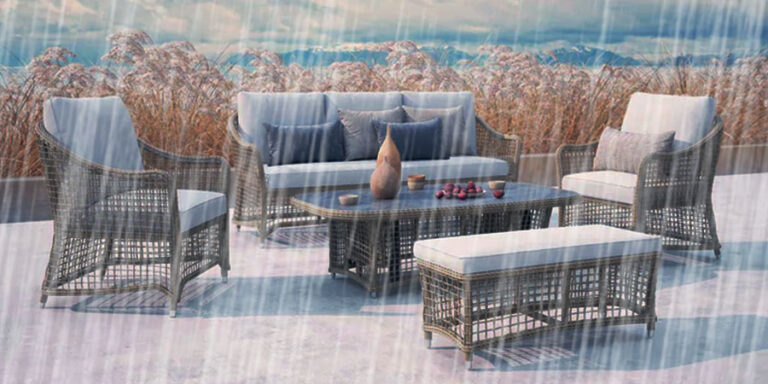Wicker furniture exudes timeless charm, adding a touch of elegance and warmth to any indoor or outdoor space. Its intricate weave patterns and natural appeal make it a popular choice for homeowners looking to enhance their decor.
However, wicker furniture is susceptible to water damage despite its beauty, which can compromise its structural integrity and aesthetic appeal. This article will explore various creative ways to protect your wicker furniture from water damage, ensuring its longevity and visual allure.
Understanding Wicker Furniture:
Wicker furniture is crafted from natural materials such as rattan, bamboo, or cane, woven together to create intricate patterns. While wicker furniture is lightweight and versatile, its natural fibers make it vulnerable to moisture and humidity. Exposure to water can cause wicker furniture to warp, crack, or develop mold and mildew, diminishing its quality and appearance over time. To dive into the details, read Jardina blog.
Traditional Methods of Protecting Wicker Furniture:
- Indoor Use and Storage: One of the most effective ways to protect wicker furniture from water damage is to use it indoors or store it in a covered area during inclement weather. By keeping wicker furniture away from direct exposure to rain or moisture, you can minimize the risk of damage and extend its lifespan.
- Protective Covers or Tarps: When not in use, covering your wicker furniture with waterproof covers or tarps can provide additional protection against water damage. Ensure the covers are securely fastened to prevent water from seeping through and reaching the furniture.
- Sealants or Protective Coatings: Applying sealants or protective coatings specifically designed for wicker furniture can help repel water and prevent moisture absorption. These sealants form a barrier that shields the wicker fibers from moisture, reducing the likelihood of water damage.
Creative Ways to Protect Wicker Furniture from Water Damage:
- Incorporating Waterproof Cushions and Pillows: Invest in waterproof cushions and pillows made from moisture-resistant materials such as outdoor fabric or vinyl. These cushions provide added comfort and create a protective barrier between the wicker furniture and any potential water sources.
- Utilizing Decorative Umbrellas or Awnings: Install decorative umbrellas or awnings above your outdoor wicker furniture to provide shade and shelter from rain. Choose umbrellas or awnings that complement your outdoor decor while effectively shielding the furniture from water damage.
- Installing a Retractable Canopy or Pergola: Consider installing a retractable canopy or pergola above your outdoor seating area for a more permanent solution. These structures offer protection from the elements and add architectural interest to your outdoor space.
- Creating a Covered Outdoor Seating Area with Natural Materials: Construct a covered outdoor seating area using natural materials such as bamboo or thatch. This rustic-inspired shelter protects your wicker furniture from water damage and enhances the overall ambiance of your outdoor living space.
- Using Decorative Planters or Trellises: Place decorative planters or trellises around your wicker furniture to create natural shade and protection. Choose climbing plants or vines that can grow over the trellises, forming a lush green canopy that shields the furniture from rain and sun.
DIY Solutions for Water Damage Prevention:
- Making Your Own Waterproof Covers or Tarps: If commercial covers or tarps are not readily available, consider using waterproof materials such as heavy-duty plastic or outdoor fabric. Measure the dimensions of your wicker furniture and create custom covers that fit snugly to provide maximum protection.
- Applying Weatherproofing Treatments Using Household Items: You can create DIY treatments using household items such as linseed oil, beeswax, or clear waterproof sealant. Apply the treatment to the wicker furniture using a brush or cloth, ensuring complete coverage to repel water effectively.
- Designing Custom Drainage Solutions: Design custom drainage solutions for outdoor wicker furniture to prevent water accumulation and pooling. Elevate the furniture slightly off the ground or install drainage holes in the bottom to allow water to flow freely away from the wicker fibers.
Maintenance Tips for Long-Term Protection:
- Regular Cleaning and Maintenance Routines: Establish a regular cleaning and maintenance routine to keep your wicker furniture pristine. Use a soft brush or cloth to remove dirt and debris, and gently scrub any stubborn stains with a mild soap solution.
- Inspecting for Signs of Damage: Regularly inspect your wicker furniture for signs of water damage, such as warping, cracking, or mold growth. Address any issues promptly to prevent further deterioration and preserve the furniture’s integrity.
- Storing Wicker Furniture Properly: When not in use, store your wicker furniture in a dry, well-ventilated area to protect it from moisture and humidity. Avoid storing wicker furniture in damp basements or outdoor sheds susceptible to mold and mildew growth.
Conclusion:
Protecting your wicker furniture from water damage is essential to maintain its beauty and longevity. By incorporating creative solutions such as waterproof cushions, decorative umbrellas, or DIY weatherproofing treatments, you can effectively safeguard your wicker furniture from the harmful effects of moisture. Remember to establish a regular maintenance routine and promptly address any signs of damage to ensure that your wicker furniture remains a timeless centerpiece of your indoor or outdoor decor for years to come.

